We explain what the scorpion is, when it originated and what its anatomy is like. Also, what are its characteristics, classification and more.
What is a scorpion?
Scorpions or scorpions are called an order of approximately 1,400 different species of arachnid , provided with a pair of pincer-shaped front appendages and a tail ending in a poisonous stinger. It is one of the world's largest predators of arthropods . In some cases, the power of its venom can damage large animals, including humans .They are solitary animals , that do not make herds and that only seek their fellow men to procreate . They generally have nocturnal and stealthy habits that keep them away from their natural enemies and from many competitors and predators.
Scorpions have fascinated man during their existence , becoming a symbol of dangerousness and aggressiveness. It is part of different mythological traditions, especially as a giant animal.
More recently, studies regarding the venom of certain species of scorpions have suggested a possible application in the treatment of cancer , but no concrete results have yet been found.
Origin and evolution of the scorpion
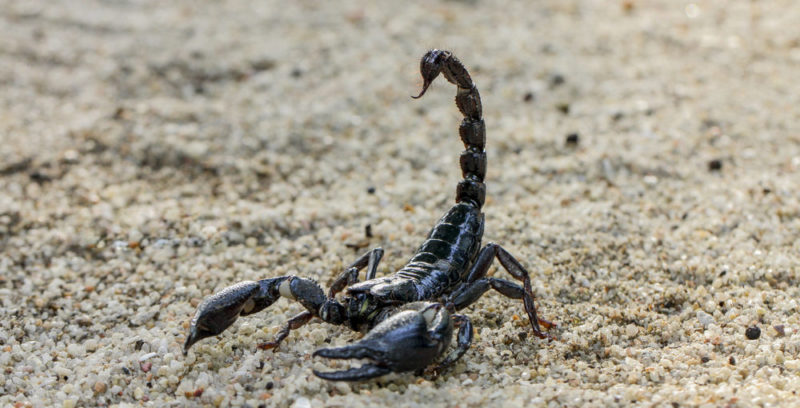 Scorpions are the oldest group of all arachnids , so they share traits with all animals of that class, such as spiders and mites.
Scorpions are the oldest group of all arachnids , so they share traits with all animals of that class, such as spiders and mites.Its anatomical constitution suggests that the species came from extinct marine arthropods , such as eurypterids, since the scorpion's lungs occupy the same place as their gills.
The oldest fossils of scorpions suggest their appearance around 400 million years ago in the Silurian period, probably as amphibian forms that still breathed underwater . They later gave way to the terrestrial variant in the Carboniferous or Devonian period , about 325 million years ago.
Scorpion Anatomy
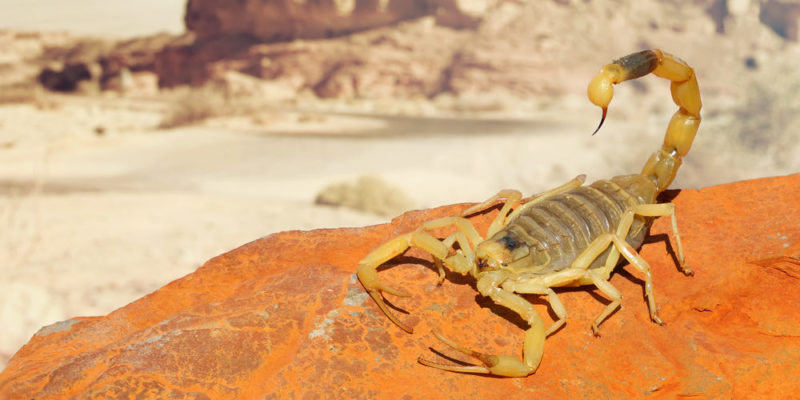 The scorpion's body is always protected by a system of chitin plates , called the exoskeleton. It is a segmented body, clearly divided into:
The scorpion's body is always protected by a system of chitin plates , called the exoskeleton. It is a segmented body, clearly divided into:
- Cephalothorax or prosoma. The front trunk of the animal, where its internal organs are and which supports the limbs. It is supported on four pairs of legs, and has eyes (two medial and up to five simple minor ones), the brain, the mouth and the chelicerae next to it, with which it tears the food.
- Abdomen or oppositosome. The rear region of the body contains thirteen ring-shaped chitin segments, flexibly bonded together, giving it great mobility despite its toughness and external rigidity. This region is in turn divided into two:
- Mesosome. The digestive and reproductive systems reside here , as well as the combs or pectenes, unique sensory members of the species, specialized in the reception of chemical and mechanical stimuli.
- Metasome. The narrower and cylindrical abdominal region, culminating in the tail with the stinger. The poisonous glands are housed there.
- Extremities. A pair of front pliers with which to hold prey or dig tunnels in the ground, as well as its eight strong and segmented legs.
Types of scorpions
Scorpions are classified into 16 families:
- Pseudochatidae . Fine, thin body, yellowish in color.
- Buthida . The most diverse in size, ranging from 2 to 12 centimeters.
- Microcharmidae . 15 species of tiny scorpions (between 8 and 18 millimeters).
- Chaerilidae . South Asian scorpion family.
- Cactidae . They have a carapace without carenas and a hexagonal sternum, and about 170 species.
- Euscorpiidae . Characterized by having huge pincers.
- Superstitioniidae . From North America and large size and black color.
- Vaejovidae . Another large family, they have a characteristic longitudinal keel throughout the body.
- Caraboctinidae . Hairy scorpions, endowed with sensitive hairs on the body.
- Luridae . Of only two species, present in Greece and Turkey.
- Hormuridae . An extinct family, it was made up of only two species.
- Bothriuridae . They have a hexagonal sternum with transversal lines and some very poisonous species.
- Hermiscorpiidae . They have a wide and long body that can reach 20 cm.
- Scorpionidae . Of various sizes, including giant species over 25 cm.
- Urodacidae . Australian scorpions with only two known species.
- Heteroscorpionidae . Family of six species from Madagascar.
Where does the scorpion live?

The scorpion is found on every continent except Antarctica . Its greatest diversity takes place in the tropical and subtropical jungle regions, especially in the Mexican territory.
Normally it prefers dry environments , but there are species also adapted to the coast. On the other hand, it is nocturnal and territorial.
According to their habitat, they can be classified into four types:
- Psammophiles. Or of sandy habitat, they have very fast legs and resist dehydration.
- Lithophiles. Or rocky habitat, they tend to have a flat complexion to slide through crevices or crevices.
- Cavemen. They live underground in caves that they dig themselves with their pincers, emerging only to hunt and reproduce.
- Erratic. Those that change their habitat according to their needs and do not present a specialization of any kind.
How does the scorpion feed?
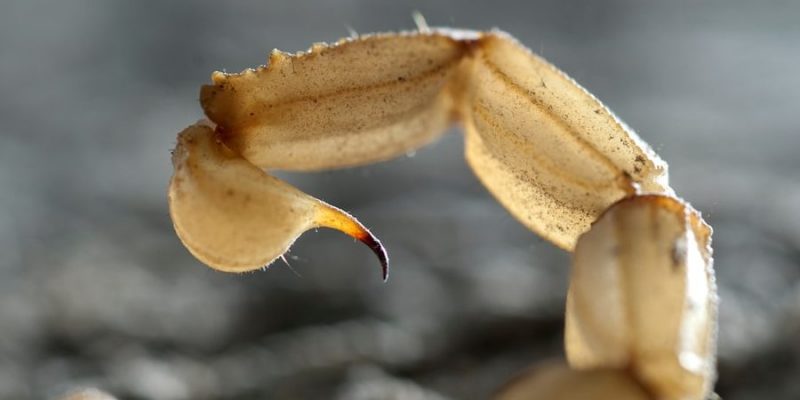
It is a remarkable hunter and always feeds on live prey of a different nature, such as insects or spiders, even other species of scorpions. It can even eat snails or small vertebrates like mice or lizards.
Its hunting technique consists of holding the prey with its pincers and inoculating it with the venom of its stinger . This causes death or paralysis and allows it to crush its prey with its chelicerae, while the venom acts as a predigestive agent. The power of a scorpion can take several hours, depending on the dam.
How does the scorpion reproduce?
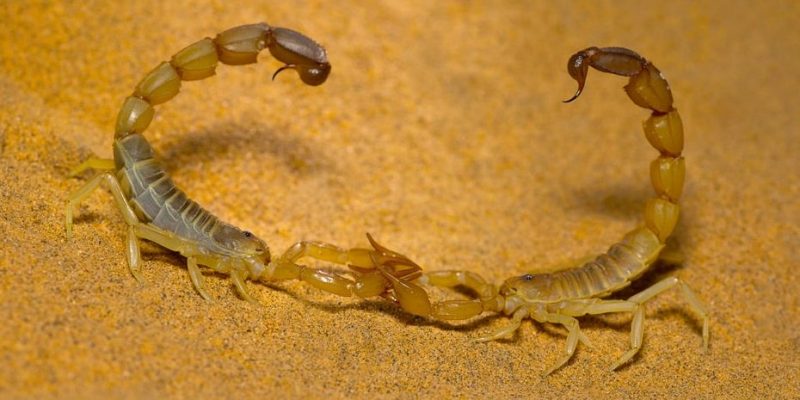
Scorpions reproduce sexually and through direct copulation , which involves complicated courtship. When the breeding season arrives, the female releases pheromones that attract males; They must then "convince" her to allow herself to be impregnated.
Courtship consists of a dance of complicated movements that culminates in holding the female with the pincers. Sometimes the male moves it for whole meters, until he finds the right position to introduce the semen into his reproductive duct.
At the end of the dance the couple quickly part ways . Depending on the species, the female can capture the male and devour him (cannibalism).
The fertilized female incubates her eggs inside the body and after several months (up to 12) she expels the live young, in a diverse number (from two to one hundred, depending on the species). Once emerged, the young have embryonic white skin .
The young climb onto the parent's back and remain there until their first molt. They feed on the secretions that the mother produces through the dermis. Then they go through five more molts until they reach adulthood .
How does the scorpion move?
Scorpions have four pairs of segmented legs that allow rapid locomotion, despite the weight of their armor and large pincers. It is capable of moving forward and backward, with little room for maneuver, as it is a hunter with not too many predators.
Scorpion Predators
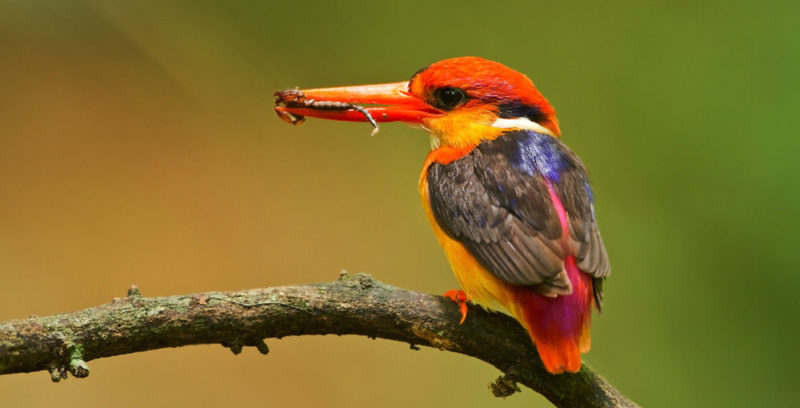
Scorpions are preyed upon by large animals , which can overcome their strong defenses and aggressive behavior. These include owls and other nocturnal birds , larger lizards, snakes , large toads, some rodents, and mammals .
On the other hand, scorpions often hunt each other and fall victim to other arachnids such as centipedes, mantises, and tarantulas.
Scorpion sting
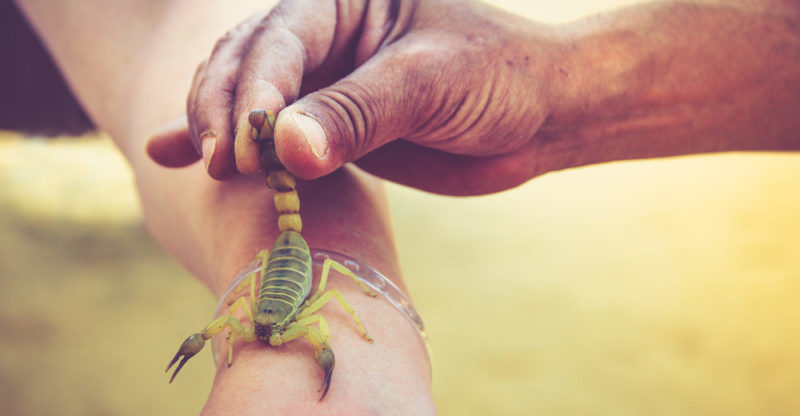
Of the 1,400 known species of scorpions, only a few are dangerous to humans (especially children), given the high levels of toxicity of their venom. Very few species have lethal poisons, such as the American bark scorpion.
The scorpion sting is usually painful, accompanied by tingling or numbness of the injured area, as well as a slight swelling around it. If it is a poisonous scorpion, symptoms may include:
- Difficulty breathing.
- Muscle contractions, unusual movements of the eyes, head and neck.
- Drooling, sweating, nausea, and vomiting.
- Hypertension, tachycardia or cardiac arrhythmia.
- Restlessness or overexcitement.
The scorpion in culture
The scorpion awakens from ancient times a combination of fear and admiration in the human being. In myths , legends and popular beliefs he appears as a threat or as a guardian of forbidden or sacred territories . Or a conspiracy weapon appears: scorpions in bed, giving scorpion venom to drink, etc.
The zodiac scorpion comes from the Orion story . This mythical hunter was killed by a scorpion sting, and both were raised to heaven by the gods. They were arranged facing each other, so that when one ascends to heaven the other is hidden and they never share the firmament.
The above content published at Collaborative Research Group is for informational and educational purposes only and has been developed by referring reliable sources and recommendations from experts. We do not have any contact with official entities nor do we intend to replace the information that they emit.
Katheryn is a corporate attorney and finance specialist, conducting research daily to get you closer to financial security and freedom (even if you're just getting started). Her +600 articles published in Collaborative Research Group have already helped thousands of readers on the internet. .
Leave a reply
Your email address will not be published. Required fields are marked *Recent post

Sport: What Is It, Types, Risks, Features, Characteristics and Examples

Dogs: Emergence, Features, Characteristics, Feeding and Breeds

Story: Definition, Elements, Structure, Features and Characteristics

